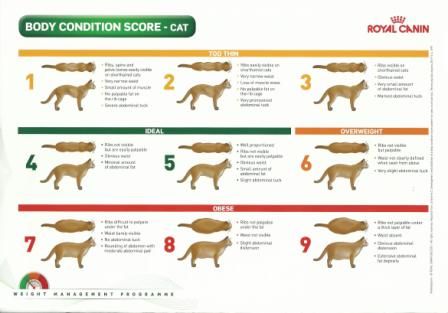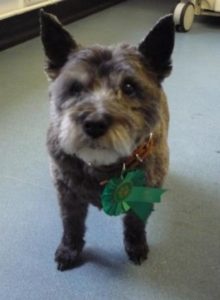With nearly 50% of our pet population clinically assessed as being overweight or obese, it is more important than ever to monitor how much and what type of food we feed our pets.
There are many reasons attributing to our pets becoming overweight and occasionally this can be down to medical reasons but as with humans the most common reason is overeating-consuming more calories than they actually need and use!
Several factors can make it more likely that your pet will become overweight including lack of exercise, overfeeding during their growth period (increasing the number of fat cells the body produces), their breed, age and whether they have been neutered. Neutered animals require up to a 30% reduction in their daily feeding requirements as their energy needs decrease dramatically after neutering.
Although an overweight pet may seem extra cuddly to you, being overweight can lead to serious health problems including:
- Joint and mobility problems-including cruciate disease and arthritis
- Diabetes Mellitus
- Heart disease and high blood pressure
- Respiratory difficulties
- FLUTD in cats-Feline Lower Urinary Tract Disorder
- Decreased quality and length of life
How do I know if my pet is overweight?
Often pet owners do not realise their pet has gained a few grammes or kilos as you are used to seeing them every day and don’t notice the changes. Your veterinary surgeon will usually notice any changes in your pet’s weight at their annual booster appointment and this can be a good time to address any issues there may be about your pet’s weight. Being even a few kilos overweight can cause vital body organs to become encased in fat, reducing their ability to function considerably.
Many studies have been carried out on overweight pets with Royal Canin at The University of Liverpool. They perform special scans called DEXA scans (Dual-Energy X-Ray Absorptiometry). These analyse the animal’s body composition including the amount of fat present.
In a healthy pet you should be able to comfortably see and feel their ribs and waistline. You may have noticed subtle changes such as reluctance to play or exercise as much which can all be indications of being overweight.
At Cinque Ports Vets we will happily check your pets’ weight and offer any help and advice needed at our Weight Clubs. We will also help you assess your pet using a Body Condition Score Chart like the example below. A healthy pet should score 4-5/9.
How can I help my pet lose weight?
The first step would be attending one of our weight clubs to establish how much weight your pet would need to lose. If your pet is only slightly overweight a simple reduction in your pet’s everyday diet or treats and an increase in their exercise and activity levels may be all that is required.
If however your pet has a substantial amount of weight to lose your veterinary surgeon or nurse may recommend a change in their diet to a prescription calorie controlled diet. Your veterinary nurse will calculate a tailor made weight loss program to help your pet lose weight. Depending on the amount of weight to lose this can take from 12 weeks to 12 months. It is very important for the health of your pet that they lose weight safely and slowly to ensure that they only lose fat tissue instead of muscle mass. It is helpful to attend the club every 2-3 weeks so your veterinary nurse can assess this. It is not advisable to drastically reduce your pet’s usual food as this reduces the amount of nutrients they receive and can affect their health.
Once your pet has successfully lost weight they will be put on a weight maintenance program to help ensure that the weight doesn’t come back! Unfortunately your pet will always be prone to gaining weight easily if their diet isn’t strictly controlled but your veterinary nurse can help and advise on which feeding regime will most suit your pet after their diet.
Tips for exercising your dog
- Regular and appropriate exercise is vital for maintaining your dog’s health and is especially important for weight loss. If your pet is overweight it is important to introduce extra exercise slowly. Begin with their usual exercise and try adding an extra 5 minutes. If your pet copes well with this increase for a week or so you can try increasing to the next level.
- Overweight dogs with joint disorders will probably find uneven and hilly walks uncomfortable and too strenuous. If it becomes difficult to increase their exercise, hydrotherapy can be helpful.
- Make sure you play with your dog and their favourite toy for at least 5 minutes every day.
- Use treat toys to make your dog work harder for their food but remember to make sure the food is taken from their daily allowance.
Tips for exercising your cat
- Make sure your cat’s indoor environment has plenty of toys and activities, allowing natural behaviour such as climbing or hunting. Activity centres can be useful as this provides exercise opportunities even when you are out.
- Buy a few extra cat toys- make sure you rotate them every few days as cats easily lose interest.
- Playing with your cat using a fishing toy or a feather tickle stick are great ways of encouraging exercise and your cat will benefit from spending time with you. Cats are designed to have short bursts of energy so playtime only needs to last a few minutes each session.
- Use see through treat balls (cats need to see the kibble to encourage play) to make your cat work harder for their food and try moving their feeding bowls to unusual locations to make them search for their meals.
- Groom your cat- this is great for circulation and their coat.
- Remember table scraps are inappropriate for pets-especially those on a weight loss program!
- Tasty low calorie treats are available from your veterinary practice. Educ treats are less than 3 kcal per treat and are suitable for both puppies and adult dogs. These are an ideal substitute for your pet’s usual snack.
Take a look at this list of unhealthy snacks given to pets and what they mean in human terms.
Human Equivalent
| Number of hamburgers |
Number of chocolate bars (50g) |
|
| Snacks fed to a 10kg dog | ||
|
1 small plain biscuit |
1 |
1 |
|
1 slice of buttered toast |
1 |
1 |
|
30g (1oz) cheddar cheese |
1.5 |
1.5 |
| Snacks fed to a 4.5kg cat | ||
|
1 crisp |
0.5 | 0.5 |
|
30g (1oz) cheddar cheese |
3.5 |
4 |
| 1 cup of milk | 4.5 |
5 |
Real weight loss success stories
Many pet owners have taken the step of helping their pets to lose weight successfully, along with the help of Cinque Ports Vets.
Echo Murkin
Echo is a 13 year old neutered, female Cairn Terrier. Following an investigation which included blood tests and X-rays, she was diagnosed with emphysema. Echo had been persistently coughing with considerable breathing difficulties and at the time she weighed 13kg with a Body Condition Score of 8/9.
After discussion with her owner alongside starting medication, a weight loss plan was introduced. Echo was started on Royal Canin Obesity diet to be divided into two meals a day along with a dental chew. No other treats or table scraps were allowed!
Although Echo was unable to undertake vigorous exercise due to her condition, she was exercised on a daily basis. She regularly attended the weight management club and continued with her prescription diet.
Her symptoms have completely resolved and Echo now has a perfect Body Condition Score of 4/9 and weighs 9.9kg!


Useful books:
Caring for an overweight cat by Andrea Harvey and Samantha Taylor




